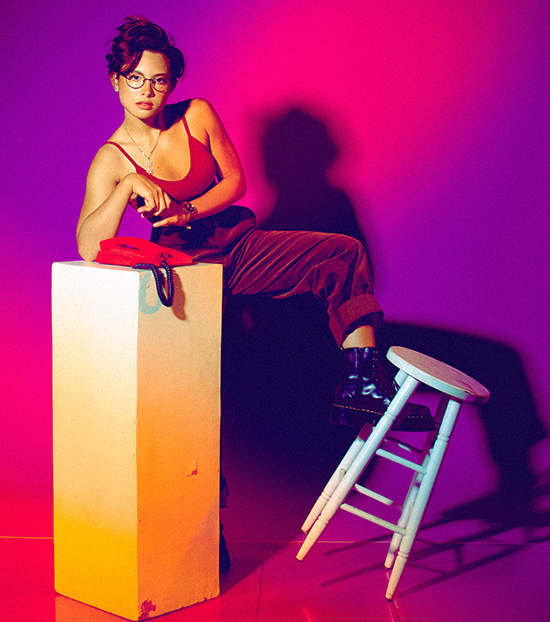The show must go on(line)
Young Star catches up with six theater actors about their migration to digital media, the future of the theater industry, and pursuing their passions in the midst of a pandemic.
At this point in 2020, it’s safe to say that most of us have accepted life under quarantine, albeit grudgingly. Gone are our naïve hopes that “Maybe this will all blow over by Christmas!” Although it’s nice to imagine that life will somehow magically go back to normal as soon as the clock strikes 12 on New Year’s Eve, we all know that’s highly unlikely.
While a lot of businesses have been able to adjust and resume operations, one sector has been stuck in
limbo since March: the theater industry. With its reliance on mass gatherings, it will probably be a while before we can see a live play or musical again. But as the old adage goes, the show must go on, and for these six theater actors, that’s exactly what happened.
Young STAR caught up with theater actors Migs Almendras, Rachel Coates, Gab Pangilinan, Ian Pangilinan, Franco Ramos and Teetin Villanueva to chat with them about their migration to digital media, what the future of the theater industry looks like, and pursuing their passions in the midst of a pandemic.
YOUNG STAR: How did you get into acting for digital media? Was pursuing acting during this pandemic something you set out to do?

GAB PANGILINAN: Like everyone else at the beginning of the quarantine, I was in my own bubble, just doing my own thing and trying to make the most of the given circumstances. In May, Resorts World Manila, in partnership with ABS-CBN, decided to stream Ang Huling El Bimbo the Musical as a fundraiser for COVID relief operations. The impact came as a surprise to us and it was (with) that stream that everything literally changed. That’s when I got encouraged to start working again. Prior to that, I was stuck in my bubble and AHEB popped it — in a good way. It was only a few weeks after the stream that I was invited to audition for My Lockdown Romance.

MIGS ALMENDRAS: I became a part of Hello Stranger after Black Sheep sent out a casting call during ECQ, and I auditioned via Zoom. I eventually got a callback, and they made me read until I eventually ended up portraying Junjun in the series and (the upcoming) movie.

IAN PANGILINAN: I auditioned for Gaya sa Pelikula initially because I was familiar with the team that was going to be behind it. I knew of their previous work, and being someone who valued creating art via acting, it was an opportunity I simply couldn’t let pass.

FRANCO RAMOS: I was super surprised when Ian (Pangilinan) asked for my number to audition for a role. At the time, I was looking for graphic design jobs online... I really missed acting. Our first message was on Aug. 12, I sent in a video on the 14th, I was offered the role on the 17th, and I was on set by the 30th. One of the craziest three weeks of my life, but a very welcome surprise.
A lot of the digital media content being released this year celebrates BL (Boys’ Love) and GL (Girls’ Love) stories, which is fantastic! Do you think that, in these trying times, there has been a heightened need for stories that celebrate all kinds of love?
MIGS: LGBTQ+ themes had been present before this pandemic, but what is good right now is that there is a current boom. More and more people are being exposed to these stories. A lot of content is being made and I think the spotlight on these stories has long been overdue. We should always celebrate all kinds of love.
FRANCO: I think the need has always been there, which is why the BLs from other countries are already so popular here (in the Philippines). I’m glad people are celebrating these stories right now, and that these stories are being told to a larger local audience, but the need for them has always been this high.
TEETIN VILLANUEVA: What I noticed is that people are looking for sources of kilig. For as far as I can remember, we have constantly been exposed to love stories involving a male and a female, while LGBTQ+ characters are usually in the supporting cast as the sawing best friend or the noisy kabarkadas of these leads. In these stories, hindi sila sawi. Sila ang bida. Their own love stories are finally represented and celebrated in mainstream media.
Do you have certain aspects you take into consideration, as an actor, when bringing these particular stories to life?

RACHEL COATES: As a queer woman, of course. I want to tell a broad range of stories in this lifetime, but stories about LGBTQ+ youth with their own agency will always have a special place in my heart. I think that now, more than ever, no matter how much people will try to deny it, there is an element of social responsibility in what we present to the world. I want to help make good things, that help people to be good.
TEETIN: I made sure that I educated myself. Even prior to auditioning, I knew that I had to learn as much as I could about the genre and the community. Whenever I accept projects, I make sure that I can represent the show well and that I truly believe in what the story stands for.
FRANCO: To be honest, I don’t consider much. I feel like that sounds weird, but I’m an actor with a pretty specific skillset: I’m not conventionally attractive, I’m on the bigger side, I’m not tall, and some people might find it hard to look past my queerness. I’m very lucky with (my character) Tito Santi because he was initially meant to be an older character, so I wasn’t quite sure how I’d be able to bring him to life. But as an actor, I end up going for roles I’m not quite fit for anyway, because you never know! Tito Santi’s a character I wish I had in my life growing up — that kind of guiding light at the end of my gay tunnel — and all I really wanted to achieve with him was to play him with warmth and honesty, so that whoever’s watching can feel the kind of support that (the other characters) get from him too, even through just a screen.
Can you walk us through your creative process as a theater actor versus acting for digital media?
RACHEL: (Pearl Next Door) happens to be my very first TV series role, and it’s been a wild experience because I’m not only getting used to that for the first time, but also being a beginner in framing, lighting, rigging, sound production. In theater, I feel like the key is preparation and honing in to your fellow actors so that you’re on the same page of the same story. A story well-told is the same goal in this virtual setup as well, but I think that, especially for (film and TV), understanding the medium, and how “screen life” works, makes a huge difference.
IAN: The process of acting in theater is more of a marathon, seeing as the actor goes through the entire story chronologically and without rest — save for the intermission. Acting for the camera is more several sprints of brilliance per scene that you have to piece together like a puzzle with the other scenes.
GAB: I would say digital media is a lot more fast-paced. (As a theater actor, there’s a process that I’m kind of used to.
Although I have done digital shoots in the past, this is the first time that I’ve had to shoot from home. Like I said, it’s more fast-paced because we don’t have the luxury of the rehearsal process, or being in a rehearsal space where we can workshop or have fixed hours. There’s none of that. At least for me, it was a trial-and-error kind of thing in terms of finding a creative process that works.
You’ve probably been asked this a million times — but what do you miss about live theater?
MIGS: Definitely it’s my co-actors and being able to perform in front of an audience. In theater, there is a certain bond that you develop throughout the process, from rehearsals up until the shows. It’s always delightful to explore, learn, and discover alongside your co-actors. With regards to the audience, being able to feed off their energy is something I miss as well.
IAN: Actually hearing the audience’s reaction to your work. One of the things that sometimes makes theater much easier to calibrate compared to digital shows is that when one part of your performance fails to hit a note with the audience, you can adjust it in the following show. When it comes to releasing digital content, it’s more of a “one-time big-time” gamble that what you put out will hit a note with the audience.
FRANCO: I miss literally everything about live theater. Being in a rehearsal space for a month or two, performing a show over and over, and finding new things to explore about it every single day. I miss being with my people. But that also has to do with me missing everything about life before COVID. I absolutely hate when people call this the “new normal.” This isn’t normal. And it shouldn’t feel normal either.
How do you think theater practitioners can keep the spirit of theater alive, when mass gatherings (and therefore, live theater) won’t be possible for the forseeeable future?
IAN: Though not the same without a live audience, I think the central idea that a piece of storytelling tries to achieve is connecting with the people watching. That doesn’t change. Whether the look or the vehicle for storytelling changes, the goal and the stories remain the same. As such, finding ways to tell these stories is how we keep the spirit alive.
GAB: What I have found — at least in the past months — is the value of sustaining and deepening genuine connections. And in theater, that’s what it’s all about as well: human connection. The spirit of theater is the people of theater. It is always going to be alive. More than the physical stage, it is the spirit of the people in theater that will keep it alive for months and years to come. We may not be going onstage anytime soon, but we will continue to tell stories, be it in little boxes online.
RACHEL: I have my fingers crossed about the resurgence of live performance art. But just based on what I can see from my friends in the community, theater is just too strong to ever fall to its knees forever. Even in this pandemic, I hear whispers of people brewing ideas, people are continuing to perform and sing and teach and strengthen their online spaces, people are getting better at making props and tinkering with makeup — theater is magic and it’s far from dead. I’d love to be in the audience area or on the stage when that does finally explode.
What do you think the future of the theater industry looks like?
TEETIN: I am expecting that more theater companies are going to delve into creating content for online shows. If a large production company would invest in locking-in their whole cast and crew like in lock-in shoots for film and TV shows, why not produce and shoot straight plays and musicals for the screen? I suspect that the theater and film industry are going to mix even more in the next months and possibly years.
RACHEL: Call me an over-optimist, but I think it’s bright. As long as live music sounds different. As long as plush seats and nearby gasps and dressing up and playbills feels different. Knowing that every single time that show has been performed has been unique and different and tuned to the audience in the room at that very second. The show’s gotta go on; it never stopped.
GAB: For now, we have all these online platforms, where we can express ourselves as theater people. But of course, I will always hold on to hope that one day the curtains will rise again,
Because for sure that will happen — we just don’t know when. Stories are meant to be shared. Experiences are meant to be shared. We will find a way to keep it alive, no matter what. People from the theater are known to be resourceful, anyways! Magagawan at magagawan ng paraan ‘yan, at talagang walang makakapigil sa mga taga-teatro. Promise.
* * *
You can catch Ian Pangilinan and Franco Ramos on Gaya Sa Pelikula, Teetin Villanueva on Boys’ Lockdown, Rachel Coates on Pearl Next Door, and Migs Almendras on Hello Stranger. All four webseries are currently on YouTube. You can catch Gab Pangilinan on My Lockdown Romance, currently available on ktx.ph.
